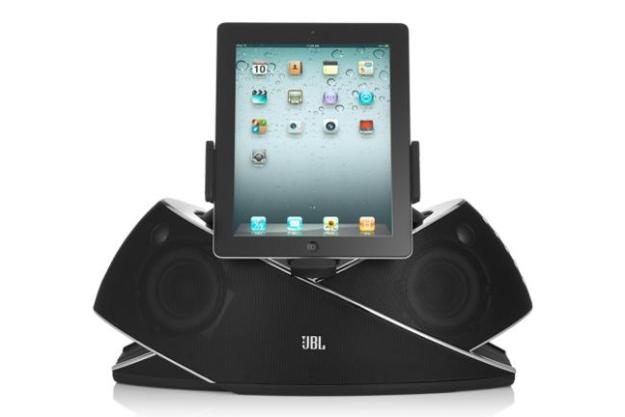
“The JBL OnBeat Xtreme may look funny, but it is the best all-around iPod speaker docks we’ve tested to date. It offers a great combination of features, sound quality and ease of use.”
- Fantastic sound quality both docked and wireless
- Easy Bluetooth pairing
- Excellent remote
- Solid build quality
- Landscape mode for iPhone or iPod
- EQ options are not necessary
- JBL “OnBeat” app not necessary
- Speakerphone sound quality not great
We’ve always had a healthy respect for JBL’s professional audio products. It has consistently built rugged, high-performance PA speakers and monitors for over 60 years and remains a favored brand of many a musician and sound engineer to this day. Its consumer audio division, on the other hand, has had its share of ups and downs. We recall a period in the late 80’s/early 90’s when JBL, like Infinity and KLH, fell out of favor with the North American audio enthusiast community, perhaps in reaction to a sudden influx of, shall we say, rather mediocre (Northridge) speaker products. Since then, it seems as if JBL’s home audio products haven’t been able to recoup the prestige they once had. But when we ran into JBL and its $60,000/pair Project Everest DD6600 speaker at CES 2007, it was glaringly obvious that JBL was on the rebound.
Over the past five years JBL has released several high-end speaker models, which have wowed us every time we’ve had the opportunity to hear them, but the company isn’t pouring its entire engineering prowess strictly toward esoteric floor-standing speakers with stratospheric price tags. It is working to make relevant, accessible products it hopes will resonate with the public, and backing them with some heavy-hitting marketing, which features the legendary Paul McCartney as front-man, no less. Case in point: The OnBeat Extreme speaker dock.
We’ve been wondering if JBL’s latest home audio products could deliver the goods, so we accepted the opportunity to evaluate the OnBeat Xtreme with no reservation. Read on to find out how this new speaker dock compares to the likes of B&W’s Zeppelin Air and Klipsch’s G-17 Air.
Out of the Box
The OnBeat Xtreme’s “weave” shape makes it an attention grabber, for sure. In fact, without an iPod or iPad mounted, you might not immediately recognize it as a speaker. We think someone with some eccentric design chops really got creative while developing this thing’s shape. Its geometry is strange, yet oddly appealing to your author (the rest of our crew thought it was…challenging to look at). To be sure, it’s one of those love-it-or-hate-it designs. At one point we actually heard someone comment that “it looks like it’s hugging itself”. Sure…that works!
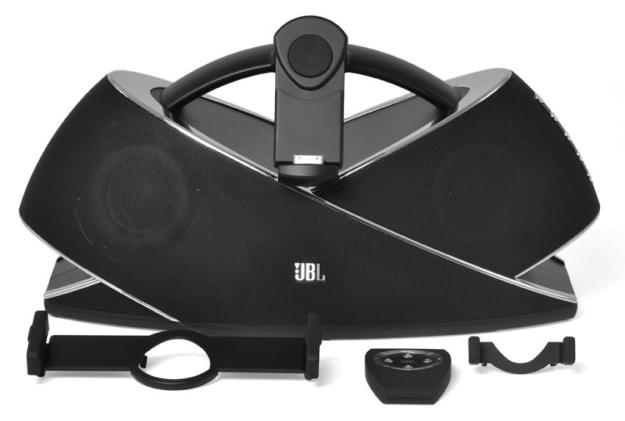
Aside from its unique shape, the OnBeat Xtreme has other appealing aesthetic features including a wrap-around grill, chrome accents (yeah, they’re plastic) and an arching dock support which doubles well as a handle. Even the metal buttons on the right hand side of the dock have a solid feel to them.
As we started pulling accessories from the box, we noticed there was no bulky power brick to deal with (yay…those things are a pain in neck!). With this much beefier model, the power supply is built in, so only the provided detachable AC cord is needed. Also provided in the box was a remote control, USB cable, docking clips for iPhone/iPod Touch and iPad and a product manual. Though this unit offers composite video output and a ⅛-inch auxiliary input, cables for these connections are not included.
The unit weighs 9 respectable pounds and measures approximately 9 x 17.5 x 9.5 (H x W x D, in inches).
Features and Design
One of the OnBeat Xtreme’s key benefits over competing speaker docks is its floating docking connector and the clips that come with it. The iPhone and iPad clips snap into place on the reclined, rubber-padded device backing in order to hold either device securely in place. That’s not all, though. The docking connector can be rotated 90 degrees to hold devices in landscape mode, which we found especially useful when watching videos or movies.
The OnBeat Xtreme uses Bluetooth for wireless audio streaming. We find it interesting that JBL opted for Bluetooth wireless technology rather than Apple’s AirPlay for its top-of-the-line speaker dock. From our experience, Airplay usually sounds better than Bluetooth and, from a setup and use standpoint, AirPlay is almost always easier to deal with. As we’ll soon discuss, however, JBL’s choice to use Bluetooth turned out to be a really smart move.
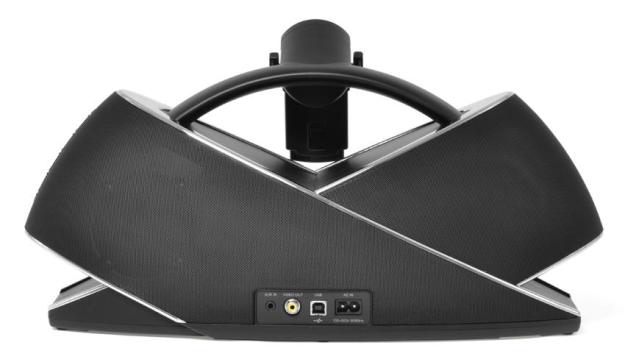
Initially, we thought the USB input would allow playback of audio from a laptop or desktop computer. It turns out that is not the case. The USB input simply allows users to synch their iPod or iPhone with iTunes on the connected computer (which is convenient). Unfortunately, the cable is only 4 feet long (not as convenient). At any rate, the provided ⅛-inch auxiliary input makes it compliant with just about any device with an analog audio output, so the lack of USB audio input isn’t such a big deal.
The nifty features keep on coming. A composite video connection comes in handy for feeding video from an iDevice up on a larger screen. The included rubberized remote control works on RF, so you don’t have to see the dock to control it, and the button layout is intuitive, to boot.
The dock features a built in microphone allowing users to take a phone call while playing music. The catch is the iPhone must be paired with the dock in Bluetooth mode. The speakerphone feature doesn’t work if the iPhone is simply docked, which doesn’t make a whole lot of sense to us.
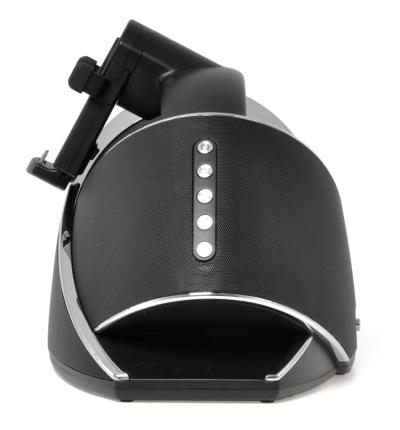
Finally, for the energy-conscious, there’s an auto-off feature which kills the power when not in use. Power consumption in standby mode is listed as 0.5 watts.
Want some tech specs? Here ya go: The OnBeat Xtreme is armed with two woofers and two tweeters. The size of the drivers isn’t disclosed at JBL’s website but we’d guess the woofers come in at around 3.5 inches and the tweeters at 1 inch. For enhanced bass, a rather large port is cleverly hidden on the back side of the dock behind its wrap-around grill. The output power rating for this unit is listed as 30 watts x 4, leading us to believe that the total system power would be around 120 watts.
Performance
Associated equipment for our JBL OnBeat Xtreme review included an iPhone 4S, iPad 2 Wi-Fi, Dell N5110 laptop and a HeadRoom Micro DAC.
We make a habit of breaking in any speaker or headphone for a good 40 hours before we give it a critical listen. If there’s any chance the speaker might sound better after break-in, best we give it a shot. The OnBeat Xtreme, however, never got any formal break-in time because we loved the way it sounded right out of the box.
In terms of sound quality, this speaker dock is absolutely on par (and in some senses, better) than the B&W Zeppelin Air and Klipsch G-17, both of which cost a bit more. To say it sounds great for a speaker of its size really doesn’t do the OnBeat Xtreme justice. It just plain sounds great.
Bass response is what first grabbed us. Like the G-17, the OnBeat Xtreme plays lower than you might think is possible for a system without a subwoofer involved, but this speaker doesn’t just get low, it produces tight, tuneful bass that harmonically serves the music and serves it well. We loved how guttural electric bass felt well supported all the way to the bottom, but stayed linear as it moved up into its upper register.

Not all is perfectly balanced in the bass department, though. There is a slightly disproportionate amount of punch in the 100hz neighborhood but just enough to make the speaker feel percussive — not enough to mud up the lower midrange.
With such great bass power comes great midrange responsibility. Through the magic of DSP, it is possible to have a couple of 3.5 inch drivers pretending to be mini subwoofers and still get some open, natural vocals — you just have to make it a priority and work to get it right. JBL did that. Bombastic bass never obscured even the most vulnerable vocal performances, and instruments, acoustic or electric, sounded true to life, almost moving out into the room with us. This is where we found the OnBeat Xtreme trumps the G-17 Air.
Thankfully, we were just as pleased with this speaker’s treble response. With tweeters aimed slightly outward and upward, we were concerned that this speaker dock’s high frequencies would be rolled off for listeners sitting directly in front of the dock. That didn’t turn out to be the case. The tweeters’ dispersion was just fine and treble response was great. We liked the G-17’s treble capabilities just a little bit better but by a very slim margin. The OnBeat Xtreme yields controlled highs with just a bit of detail and never gets harsh.
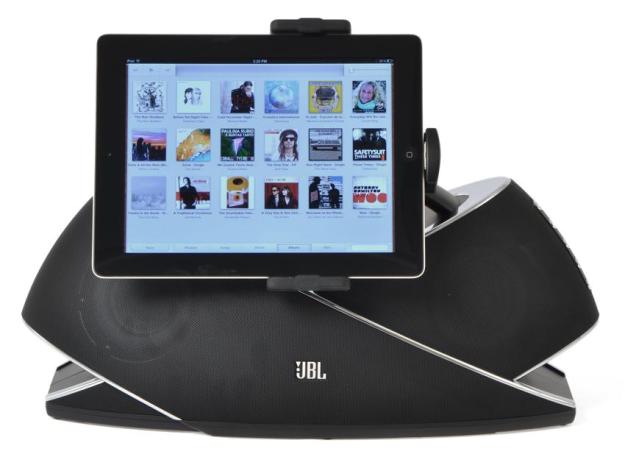
We were not all that wowed out by the speakerphone feature. Perhaps because of the microphone’s placement near the drivers, a strange noise was emitted to callers on the other end of the line as they spoke.
We have a few important notes on usability we want to share. First, this dock broke all of our pre-conceived notions about Bluetooth as far as setup is concerned. Pairing the speaker with our iDevices was extremely easy and lightning fast. Also, though we preferred the sound quality of the speaker with our iPhone or iPad docked, we did feel its Bluetooth sound quality was the best we’ve ever heard from a speaker dock. As we hinted at before, we think JBL made a smart move by going with Bluetooth here. As long as an AirPlay hardware compatibility issue exists (as it does for the Klipsch G-17 and B&O Beolit 12, at least until Apple releases an iOS update), a well integrated Bluetooth option such as this is the only way to guaranteed perfect streaming of audio from an iPhone 4S. That’s kind of a big deal.

Finally, we wanted to mention that upon connecting an iDevice, the OnBeat Xtreme searches it to figure out whether or not JBL’s OnBeat app has been downloaded. If the app isn’t installed, it flashes up a message saying, “This accessory requires an application you do not have installed. Would you like to download it from the app store now?” This really bothered us because the language used indicates the app is required in order for the system to properly function — which is patently false. The dock works just fine without JBL’s questionably useful app, save that EQ issue we mentioned earlier.
Conclusion
The JBL OnBeat Xtreme may look funny, but it is the best all-around iPod speaker dock we’ve tested to date. It offers the best combination of features, sound quality and ease of use, making it a little easier to get over its odd shape and design. We feel this speaker dock sets the bar for the $500-$600 price class, and gladly give it our Editor’s Choice award.
Highs:
- Fantastic sound quality both docked and wireless
- Easy Bluetooth pairing
- Excellent remote
- Solid build quality
- Landscape mode for iPhone or iPod
Lows:
- EQ options are not necessary
- JBL “OnBeat” app not necessary
- Speakerphone sound quality not great




